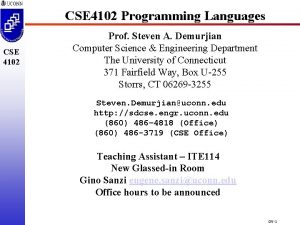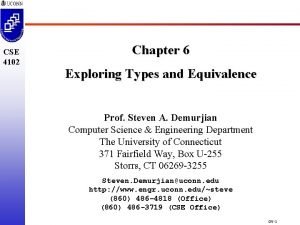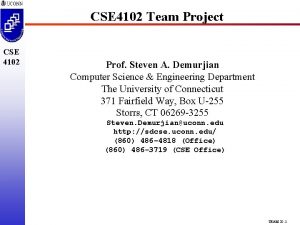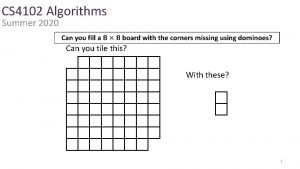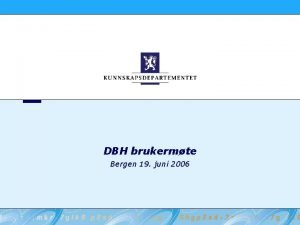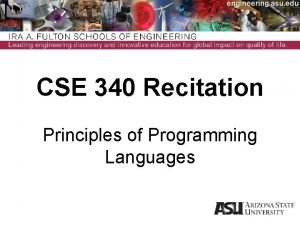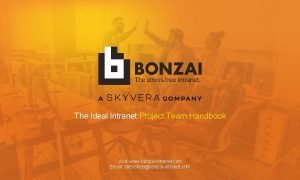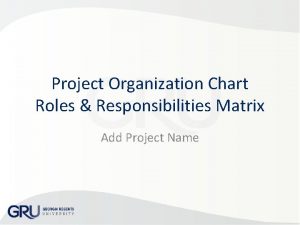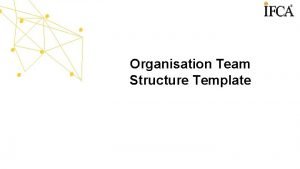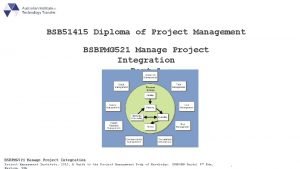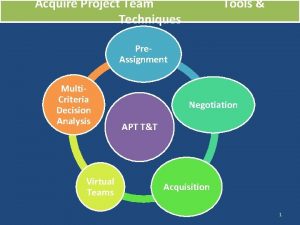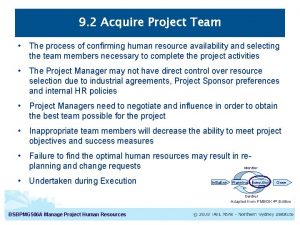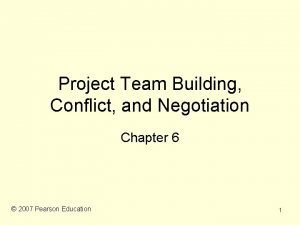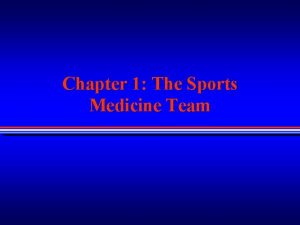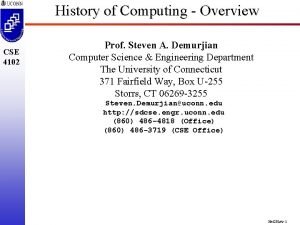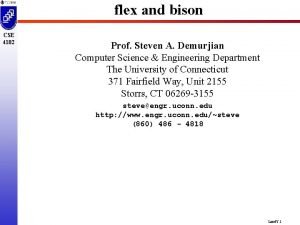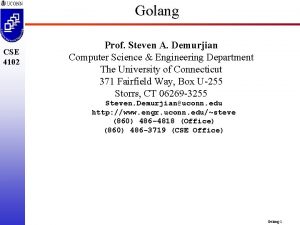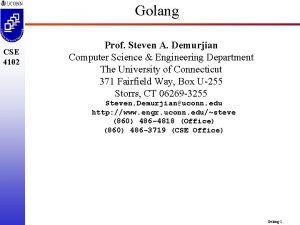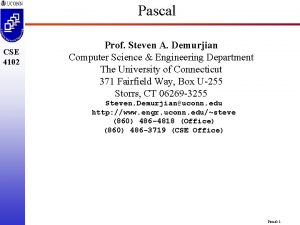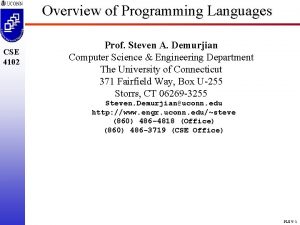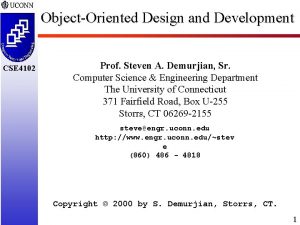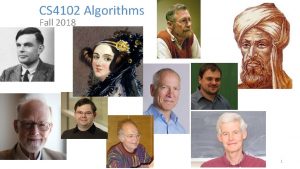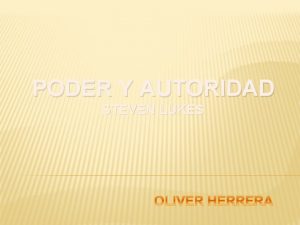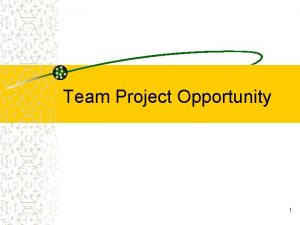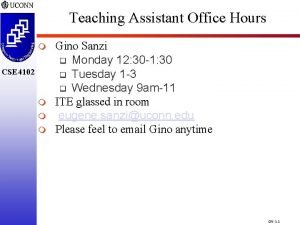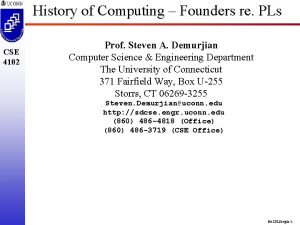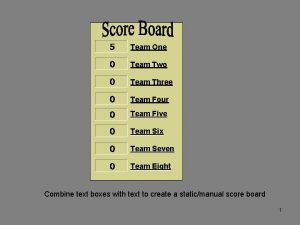CSE 4102 Team Project CSE 4102 Prof Steven
















- Slides: 16

CSE 4102 Team Project CSE 4102 Prof. Steven A. Demurjian Computer Science & Engineering Department The University of Connecticut 371 Fairfield Way, Box U-255 Storrs, CT 06269 -3255 Steven. Demurjian@uconn. edu http: //sdcse. uconn. edu/ (860) 486– 4818 (Office) (860) 486 -3719 (CSE Office) TEAM X-. 1

Team semester project m CSE 4102 m m m Form teams of 2 to 4 students Explore in-depth an old, new, or emerging programming language that supports one or more different programming paradigms Recall that a programming paradigm describes the underlying conceptual and computational model of the PL q Imperative q Procedural q object-oriented etc. See also q http: //cs. lmu. edu/~ray/notes/paradigms/ q https: //en. m. wikipedia. org/wiki/Programming_paradigm q https: //en. m. wikipedia. org/wiki/Software_development#Pr ogramming_paradigm TEAM X-. 2

http: //cs. lmu. edu/~ray/notes/paradigms/ m CSE 4102 m m m Imperative: Programming with an explicit sequence of commands that update state. Declarative: Programming by specifying the result you want, not how to get it. Structured: Programming with clean, goto-free, nested control structures. Procedural: Imperative programming with procedure calls. Functional (Applicative): Programming with function calls that avoid any global state. Function-Level (Combinator): Programming with no variables at all. TEAM X-. 3

http: //cs. lmu. edu/~ray/notes/paradigms/ m CSE 4102 m m Object-Oriented: Programming by defining objects that send messages to each other. Objects have their own internal (encapsulated) state and public interfaces. Object orientation can be: q Class-based: Objects get state and behavior based on membership in a class. q Prototype-based: Objects get behavior from a prototype object. Event-Driven: Programming with emitters and listeners of asynchronous actions. Flow-Driven: Programming processes communicating with each other over predefined channels. TEAM X-. 4

http: //cs. lmu. edu/~ray/notes/paradigms/ Logic (Rule-based): Programming by specifying a set of facts and rules. An engine infers the answers to questions. m Constraint: Programming by specifying a set of constraints. An engine finds the values that meet the constraints. m Aspect-Oriented: Programming cross-cutting concerns applied transparently. m Reflective: Programming by manipulating the program elements themselves. m Array: Programming with powerful array operators that usually make loops unnecessary. Paradigms are not meant to be mutually exclusive; a single program can feature multiple paradigms! m CSE 4102 TEAM X-. 5

Four Part Project A. Identify the Issues/Questions of chosen PL q CSE 4102 q q q B. Why did you choose your PL? What types of problems does it solve? What application domais is it relevant for? When how and who were the inventors of the programming language? 12/18/24 page final report your chosen PL for 2/3/4 members q q One member expands the part A and focuses on paradigm, origin, history, domain, & bios Other member(s) focus on language, compiler, IDE, grammar, etc. Demonstrate your chosen programming language through code using perhaps word count or word frequency program. D. 50/75/100 slide PPT presentation on your chosen programming language using the CSE 4102 template on the course web page. Each member does 25 slides on their portion from B. Also prepare a 5 -10 slide speed version to present Class Presentation Integrates Topic, Languages, and Bio PPTs C. TEAM X-. 6

Team Structure and Responsibilities m CSE m 4102 m m A final report with 12 pages for 2 person teams, 18 pages for 3 person teams, in 24 pages for 4 person teams One team member focuses on the overall introduction of the programming paradigm by: q Expanding the one page discussion in more detail q Discussing the underlying programming paradigm (e. g. , concurrent, parallel, functional, etc. ) q Explaining motivation /history of PL, bios of founders q Discussing the domain or intended application Each of the other 1, 2, or 3 team members focuses on the programming language in detail including: q Perspective of technology, compilers, supported platforms, IDE q Grammar in EBNF or yacc/bison format as an appendix For example, for object-oriented paradigm, Java, Eiffel, and C++, for a 4 person team, one team member do 4 svoverview and the other three team members assigned to a P TEAM X-. 7

Choosing a Programming Language m CSE 4102 m m Possible Languages to consider are based on categories or application domains or for specific purposes: 1. Languages for Io. T, concurrency/parallelism, machine learning, secure transactions 2. Categories as in https: //en. m. wikipedia. org/wiki/List_of_programming_lan guages_by_type 3. Time period organization as in https: //en. m. wikipedia. org/wiki/Timeline_of_programmin g_languages You cannot choose PLs in class (C, C++, Pascal, Modula-2, Ada, Prolog, Go, Fortran, COBOL), from a CSE class (Python, scheme), or widely in use (Java, Java. Script, C#, Objective-C, Swift, etc. ). Make sure you select a language that has an available compiler to utilize for demonstration and testing purpose See: https: //medium. freecodecamp. org/how-to-visualize-theprogramming-language-influence-graph-7 f 1 b 765 b 44 d 1 TEAM X-. 8

Languages For Spring 19 CSE 4102 6502 68000 befunge Bitcoin script Blocky clojure dart Django elixir elm erlang F# functional gremlin Haskell juliauh kotlin logo lucid Mathematica php R Ruby on rails rust Scala scratch smalltalk solodity truebasic TEAM X-. 9

Possible Programming Languages m m CSE m 4102 m m m Dart https: //www. dartlang. org Google general purpose/Io. T PL Rust https: //www. rust-lang. org/en-US/ Systems programming Parasail http: //parasail-lang. org Parallel Programming Julia https: //julialang. org Numerical Computing Hive. QL SQL-like for Data Warehouses https: //cwiki. apache. org/confluence/display/Hive/Home Others links to Consider q Rosetta Code http: //rosettacode. org/wiki/Rosetta_Code q https: //techbeacon. com/5 -emerging-programminglanguages-bright-future q https: //techbeacon. com/13 -programming-languagesdefining-future-coding q https: //stackify. com/popular-programming-languages 2018/ q http: //yoppworks. com/8 -predictions-of-futureprogramming-based-on-2017 -trends/ TEAM X-. 10

Teams and Due Dates CSE m 4102 m 33% per deliverable – individual and team grade Important dates q By February 4 th at 11: 59 pm: submit to Steve: a list of team members, your chosen programming language and a one-paragraph description of the language, and which team member is doing which deliverable (B and D) q By April 7 at 11: 59 pm: submit to Steve the two PPT presentations (speed and long) q Speed Presentation in Class q By May 1 at 11: 59 pm: submit your final report. TEAM X-. 11

Format/Submission Requirements m CSE 4102 m m All slides must be formatted with http: //www. engr. uconn. edu/~steve/Cse 4102/cse 4102 template. pptx Slide 2 of http: //www. engr. uconn. edu/~steve/Cse 4102/cse 4102 template. pptx has organization of final PPT. For written reports A and B, 1 page is 12 pt, 1 in margins, single spaced, Times New Roman fonts. You must submit an MS Word Document. For presentations, use Power. Point. Tables, Figures, etc. are not counted in the page requirements of B. TEAM X-. 12

Organization of Final PPT m CSE m 4102 m 50/75/100 slide PPT presentation using this template Biographical PPTs (included in 50/75) for the individuals involved in your PL See next three slides for an example Conclusion Slide TEAM X-. 13

Biography - Donald Knuth m CSE 4102 m m m In 8 th grade, won competition by finding 4, 500 words from “Ziegler’s Giant Bar” Graduated from high school in 1956 with the highest GPA ever achieved at that school Graduated in 1960 from Case Institute of Technology with a B. S. in Mathematics, was simultaneously awarded an M. S. for his achievements, an unprecedented move Received a Ph. D. in Mathematics from California Institute of Technology in 1963 Joined Stanford University as a Professor of Computer Science in 1968 In 1993, became Professor Emeritus of The Art of Computer Programming at Stanford, where he is still currently located TEAM X-. 14

Achievements - Donald Knuth m CSE 4102 m m m Authored The Art of Computer Programming, a multi -volume tome on CS Inventor of Te. X and METAFONT LR(k) parsing Knuth-Morris-Pratt algorithm 1974 – Turing Award winner 1979 – National Medal of Science 1995 – John von Neumann Medal TEAM X-. 15

Trivia - Donald Knuth m CSE 4102 m m The Art of Computer Programming began as a text about compilers Loves organ music, mostly 4 and 8 -hand music which he plays on an organ in his home, he studied piano as a child Pays $2. 56 (one hexadecimal dollar) for errors found in his books Quit using email in 1990 Processes all communications in batch-mode TEAM X-. 16
 Cse 4102
Cse 4102 Cse 4102
Cse 4102 Cse 4102
Cse 4102 Uva cs 4102
Uva cs 4102 Kontoplan ns 4102
Kontoplan ns 4102 Bureaucratic bypass syndrome
Bureaucratic bypass syndrome Team spirit becomes team infatuation
Team spirit becomes team infatuation The white team cheers for the blue team, just like
The white team cheers for the blue team, just like Cse 340 asu
Cse 340 asu Intranet ideal
Intranet ideal Organization roles and responsibilities
Organization roles and responsibilities Project team structure template
Project team structure template Dedicated project team structure
Dedicated project team structure Manage project team tools and techniques
Manage project team tools and techniques Acquire project team
Acquire project team Project team building conflict and negotiation
Project team building conflict and negotiation Sports medicine team project
Sports medicine team project
